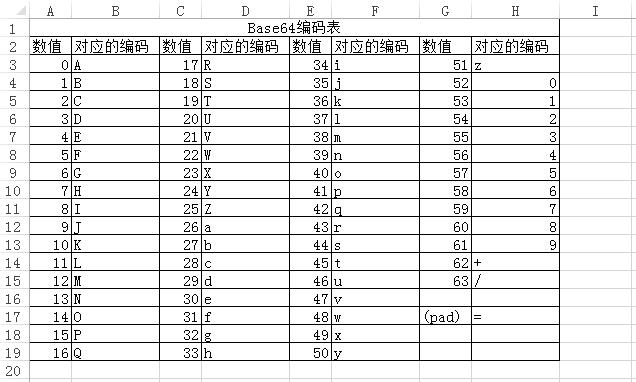base64编码是将一个8位字节序列拆散为6位的片段,并为每个6位的片段分配一个字符。
6位字节序列转化为对应的10进制值,然后根据下表找到对应的字符。

由于二进制序列流有时不能正好平均分成6位的块,在这种情况下,就在二进制序列末尾填充位数,使二进制序列的长度成为24的倍数(6和8的最小公倍数)。对已填充的二进制串进行编码时,任何完全填充(不包含原始数据中的位)的6位组都由特殊的第65个符号“=”表示。如果6位组是部分填充的,就将填充位设置为0。
比如数据”a:aa”的填充二进制位为“011000 010011 101001 100001 011000 01xxxx xxxxxx xxxxxx”
其中01xxxx是部分填充的,把填充位都设置为0,也就是变成了010000,最后2个6位组是完全填充的,用符号”=”编码,从而得出”a:aa”的base64编码为YTphYQ==。
基于以上的原理分析,可以使用如下的函数对任意的字符串进行base64编码。
Function Byte2Base64(arrByte() As Byte)
'定义一个存放3个8位字节的数组
Dim Bits8(1 To 3) As Byte
'顶一个一个存放4个6位字节的数组
Dim Bits6(1 To 4) As Byte
'Base64字符表
Const Base64Char As String = "ABCDEFGHIJKLMNOPQRSTUVWXYZabcdefghijklmnopqrstuvwxyz0123456789+/="
Dim arrBase64Char() As Byte
'把字符表转换为编码表
arrBase64Char = VBA.StrConv(Base64Char, vbFromUnicode)
' Dim arrByte() As Byte
' '要转换的字节序列
' arrByte = VBA.StrConv("上网", vbFromUnicode)
Dim bSize As Long
bSize = UBound(arrByte) + 1
For n = 1 To bSize Step 3
'lLen变量为实际转换的6位字节数组的个数
For i = 1 To 3
If i + n - 1 <= bSize Then
Bits8(i) = arrByte(i - 1 + n - 1)
lLen = 4
Else
'如果不够24的倍数,则填充0
Bits8(i) = 0
lLen = lLen - 1
End If
Next i
'将任意连续的3个8位字节序列转换为4个6位的字节序列
Bits6(1) = (Bits8(1) And &HFC) \ 4
Bits6(2) = (Bits8(1) And &H3) * &H10 + (Bits8(2) And &HF0) \ &H10
Bits6(3) = (Bits8(2) And &HF) * 4 + (Bits8(3) And &HC0) \ &H40
Bits6(4) = Bits8(3) And &H3F
'通过Base64编码表把4个6位的字节序列转换为字符
For j = 1 To lLen
sEncoded = sEncoded & Chr(arrBase64Char(Bits6(j)))
Next
'根据lLen的值,判断尾部添加几个"="号。
Select Case lLen
Case 2
sEncoded = sEncoded & "=="
Case 3
sEncoded = sEncoded & "="
End Select
Debug.Print sEncoded
Next
Byte2Base64 = sEncoded
End Function
如果是一般的非中文字符,我们可以使用如下的代码进行Base64编码:
Sub QQ1722187970()
Dim str1 As String
str1 = "asd"
Debug.Print Byte2Base64(VBA.StrConv(str1, vbFromUnicode))
End Sub
当涉及中文字符时,用以上的代码进行编码获得的是gb2312的Base64编码,由于网站经常使用的是utf-8,为此还需要通过以下的代码把unicode字符转换为utf-8编码,以免出现乱码。
Public Declare Function WideCharToMultiByte Lib "kernel32" (ByVal CodePage As Long, _
ByVal dwFlags As Long, ByVal lpWideCharStr As Long, ByVal cchWideChar As Long, _
ByVal lpMultiByteStr As Long, ByVal cchMultiByte As Long, ByVal lpDefaultChar As Long, _
ByVal lpUsedDefaultChar As Long) As Long
Public Declare Function MultiByteToWideChar Lib "kernel32.dll" (ByVal CodePage As Long, _
ByVal dwFlags As Long, ByVal lpMultiByteStr As Long, ByVal cchMultiByte As Long, _
ByVal lpWideCharStr As Long, ByVal cchWideChar As Long) As Long
Public Const CP_UTF8 = 65001
Public Const CP_ACP = 0
Sub QQ1722187970()
'unicode 转 utf-8
'定义要转换的字符串变量
Dim str1 As String
str1 = "我和你"
'定义一个变量存储接收实际转换后的字符的字节数
Dim bByte As Long
'先调用WideCharToMultiByte函数获取缓冲区字节数
bByte = WideCharToMultiByte(CP_UTF8, 0, StrPtr(str1), Len(str1), 0, 0, 0, 0)
Debug.Print bByte
'定义一个字节数组变量存储转换后的字符字节
Dim arr() As Byte
ReDim arr(bByte - 1)
'再次调用WideCharToMultiByte函数填充字节到arr数组中
WideCharToMultiByte CP_UTF8, 0, StrPtr(str1), Len(str1), VarPtr(arr(0)), bByte, 0, 0
Debug.Print Byte2Base64(arr)
' '遍历字节验证16进制值,可以将字符输入文本文件另存为UTF-8,用二进制查看器打开验证对比
' For k = 0 To UBound(arr)
' Debug.Print VBA.Hex(arr(k))
' Next k
End Sub


好用点赞